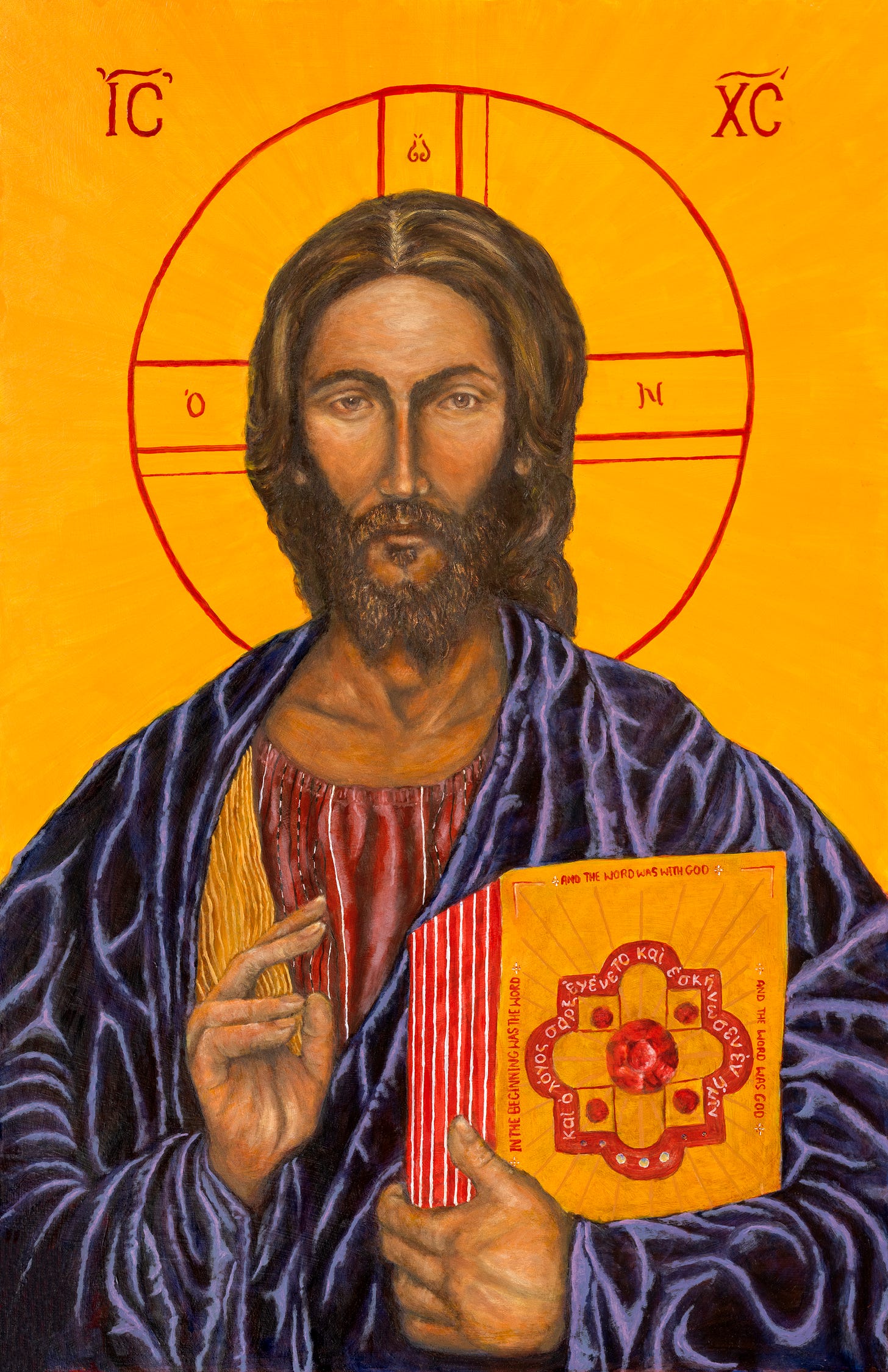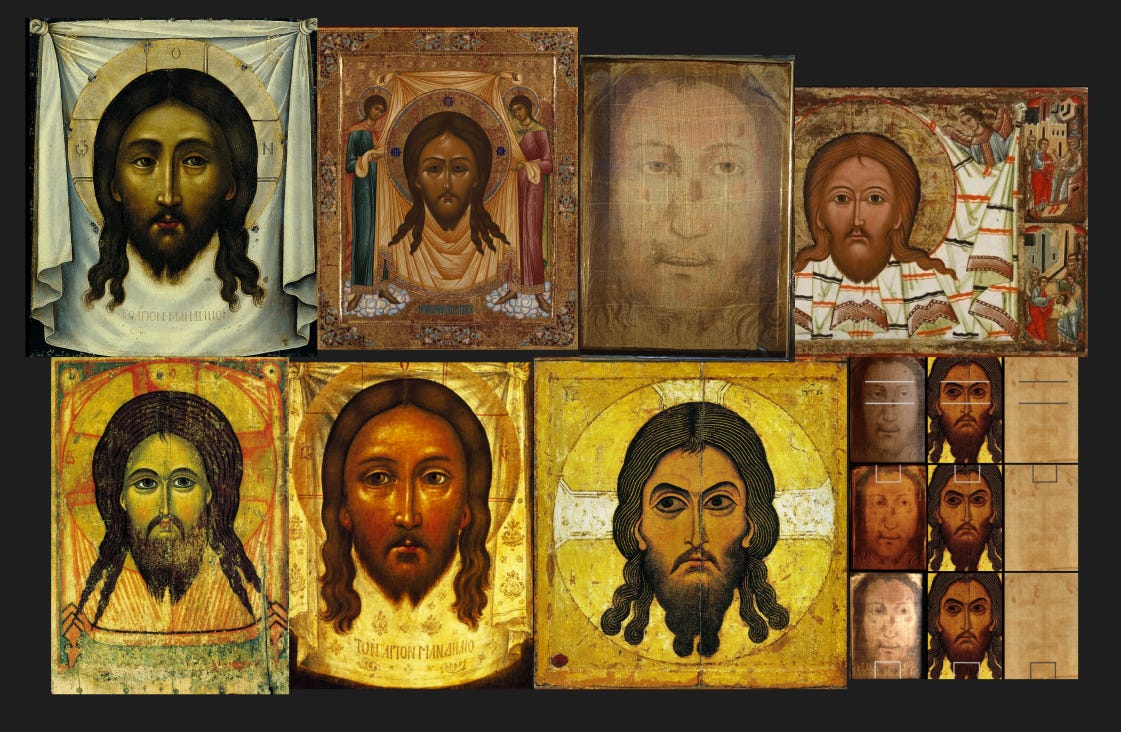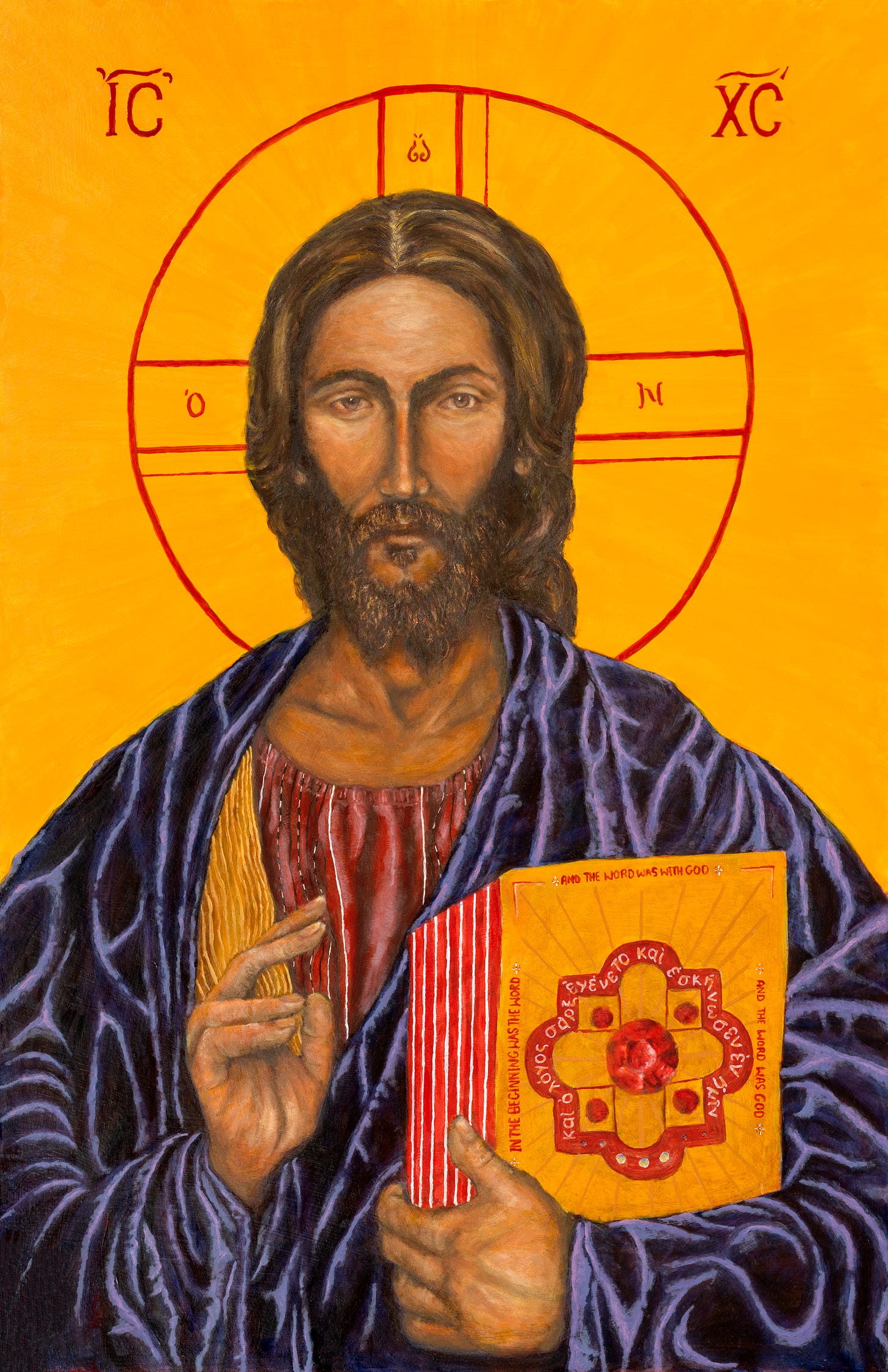Christ, the ultimate paradox
Christ is the ultimate symbol of unity in duality + my videos of Christ Pantocrator icon goes viral on social media.
Today I’m unveiling the completed ‘Christ, the Pantocrator’ icon.1 It’s the largest icon I’ve done thus far at 22 x 32 in (55 cm x 81 cm).
Christ the Pantocrator is arguably the most profound and influential genre of icons in Christian art. In them, Christ is the ultimate symbol of unity in duality: One person, two natures. Infinite and finite, immortal and mortal, uncreated yet conceived in the Virgin’s womb, timeless yet grew in age.
Note: This post is too long for email, please click ‘VIEW ENTIRE MESSAGE’ at the bottom. At the end, I’ll share how you can enter a raffle for a chance to win a full-size print of this Christ the Pantocrator icon for only $5.
True religion, as I’ve written here, is the uniting of opposites: infinite and finite, suffering and bliss, wisdom and ignorance, God and man. The greatest quest for man is to behold this paradox—unity in duality—in all its glory. I believe this paradox reaches its zenith in Christ.
This Pantocrator icon was painted in oil on a wood panel using glazing techniques. Multiple thin layers of paint, akin to the method used in egg-tempera icons, to create luminous and vibrant colours.2
This icon went viral on Instagram
If you follow me on Instagram, you may have seen this particular video on the Pantocrator icon garner over 300,000+ views and 36,000 likes. Across all social media, videos of this icon have amassed more than 700,000+ views. This exposure has opened doors—many for commissions and inquiries. I also received many rage comments and messages.
The negative messages, often filled with profanities, amuse me despite the initial shock. They typically read something like:
“f*** you, idolator. go read your bible. you’re going to hell.”
We live among modern iconoclasts (icon destroyers), and creating icons remains a polarising act. If you’re an iconoclast, don’t read further.
What does Pantocrator mean?
The term Pantocrator derives from Greek: Panto (all) and crator (ruler). Thus, ‘Christ the Pantocrator’ translates to Christ, Ruler of All.
My ‘Christ, the Pantocrator’ icon combines three objects: (1) the oldest available Pantocrator icon from St. Catherine’s Monastery, (2) the Shroud of Turin, and (3) the Holy Face icons.
The oldest known Pantocrator icon, an encaustic masterpiece, resides safely at St. Catherine’s Monastery on Mt. Sinai. It survived the century-long period of iconoclasms (8th century), when many ancient icons, including the original Pantocrator on the Chalke palace gate, were burned and destroyed.
Overlaying relics to create the face of Christ
Two additional things I paid attention to when sketching and planning this icon were 1) The Shroud of Turin & 2) The Holy Face icons.
The Shroud of Turin is believed to be the burial cloth of Christ. The most recent study, published in 2024 using Wide-Angle X-ray scattering, concluded that the Shroud is approximately 2,000 years old, with results compatible with other linens dating to at least 55 AD from Masada, Israel.3
The Holy Face of Christ icons, also known as the Mandylion, meaning ’cloth’ or Image of Edessa, is believed to be the first icon depicting the face of Jesus.
One of the notable differences between the icon at St. Catherine’s and mine is the beard, which was found by overlaying the icon with the Shroud of Turin. Then comparing this overlay to other Holy Face icons revealed a consistence feature: Christ’s split beard.
So, I preserved this tradition in my work.
A full breakdown of this icon
When we look at Christ’s face, we find multiple asymmetries. Similar to the ones found on the icon at St. Catherine’s Monastery. Christ’s wide-open eyes gaze directly at the viewer, conveying immediacy and timelessness (echoing the paradox of God-man).
The first asymmetry we notice is that the figure itself is pushed towards the right side (our left). This is obvious when looking at the cruciform halo.
Second, the pupils are misaligned. Third, his left eyebrow is raised higher. His hair and beard are parted off-centre. The hair falls more heavily to his left side.
These deliberate asymmetries embed the theological truth of the nature of Christ: Fully divine and fully man; two natures, one person. Again, reminding us that he is the ultimate paradox.
IC XC are the first and last letters of Ἰησοῦς Χριστός (Jesus Christ) in Greek.
The Greek letters inside the cruciform (cross-shaped) halo read, ὁ ὤν. This translates to ‘The Exististing One’ or the ‘I AM’. Indicating that Christ was the one who spoke to Moses at the burning bush on Mt. Sinai (Ex. 3:14).
And the Lord said to Moses “ἐγώ εἰμι ὁ ὤν” (I AM ὁ ὤν)
Further, the ὁ ὤν alludes to John 8:58 when Christ says,
Truly, truly I say to you, before Abraham was, I AM.
Together they point to Christ as the Existing One and the promised Messiah.
The hidden face of Christ
To see this most clearly, imagine splitting Christ’s face down the centre and mirroring it. We’ll start with the left side.
Let’s duplicate and then flip it horizontally. This produces a stern, powerful face, showing us Christ as ruler, judge, and Divine One.
Then, if we do this to the right side of the face, duplicating it and then flipping it horizontally, the icon yields a face of mercy, kindness, and empathy. Showing us Christ, the man, who understands human suffering. Revealing Christ in his full humanness.
So encapsulated in this icon of Christ is the Christian message that God became fully man for our sake:
For [God] was made man that we might be made God; and He manifested Himself by a body that we might receive the idea of the unseen Father; and He endured the insolence of men that we might inherit immortality.4
This is theosis. God became man so that man might become God. Put differently, matter is made holy through the incarnation.
In Christ’s left hand, he holds the Scriptures. Inscribed are two verses from the Gospel of John. The first is John 1:1:
In the beginning was the word and the word was with God and the word was God.
The second within the cruciform at the middle is John 1:14 in Greek:
Καὶ ὁ λόγος σὰρξ ἐγένετο καὶ ἐσκήνωσεν ἐν ἡμῖν (And the Word became flesh and made his dwelling among us).
These verses underscore Christ as the incarnate Word, the fulfilment of the Scriptures.
We also find four smaller rubies, symbolising the Gospel writers—Matthew, Mark, Luke and John—surrounding a central larger ruby, Christ.
Christ’s right hand is raised in blessing, with the index and middle fingers extended to signify his dual nature as God-Man.
The thumb touching the ring and pinky fingers represent the Holy Trinity.
Christ’s attire further proclaims his sovereignty. The purple robe/overgarment (himation), a colour historically associated with royalty and the golden band (clavus) over his right shoulder signifying his status as ruler of the cosmos.
Finally, the reddish-brown undergarment (chiton) speaks to his human nature. This colour is often associated with matter or ‘dirt’ from the name of Adam, which derives from two Hebrew words ‘adamah’ (earth) and ‘adom’ (red). The Tangkhul pattern on the undergarment is a reminder of the Great Commission (Matt 28 19 -20)5, namely, that Christ is for all mankind, for all times, even distant, unreachable groups.6
This is why ‘Christ, the Pantocrator’ is one of the most profound icons in history. The icon invites us to behold the ultimate paradox. It calls us to contemplate the great mystery of the incarnation. To reiterate the aforementioned quote from St. Athanasius, “For He was made man that we might be made God.”
If you’re interested in a limited print of ‘Christ, the Pantocrator’, click ‘Order now’ on your print size below. Prints are on acid-free, archival Hahnemuhle Photo Rag Paper. Free shipping worldwide.
You can purchase non-limited prints here!
In the meantime, I’m accepting a limited number of icons and painting commissions. Whether for your personal devotion, religious community, children’s baptism, or as a gift, now is the time to secure your spot. Reply to this email or book a time here.
I’ve spent the last year studying iconography because many of the conclusions I had arrived at about beauty, meaning, enlightenment and religion I found within iconography tradition. And in wanting to learn more, I took iconography classes with Ian Knowles. For those who know their modern icon landscape, Knowles was Aidan Hart, the Orthodox iconographer’s first student.
The most common medium used for painting icons on wood panels.
Liberato De Caro, et al. X-ray Dating of Ancient Linen Fabrics: New Perspectives for the Shroud of Turin. https://www.mdpi.com/2571-9408/5/2/47
Athanasius, On the Incarnation.
Matt 28, 19 -20 (NIV): “Therefore go and make disciples of all nations, baptising them in the name of the Father and of the Son and of the Holy Spirit, and teaching them to obey everything I have commanded you. And surely I am with you always, to the very end of the age.”
Christ’s message reached the Tangkhul tribe—the tribe I belong to—in 1899 AD under William Pettigrew.
















Came across this painting on google Images and had to stop and do the 'cover the side with my finger' thing for like 5 minutes. This is truly profound, perhaps the best asymmetric pantocrator there is. So subtle yet so meaningful. So much that can be drawn from this artwork. I'm genuinely astounded that this is a modern work.
Cesar Borgia deserves a mention… And, I was hoping you would unpack the symbolism represented by the posture of the fingers on the right hand… and more…
This is a great way to demonstrate how what we observe as a religion and the “iesus” that we consider the “Ben Yahuah” are both vile corruptions of the Babylonian syncretism that has been the basis of our man-made framework of social control.
Great work, IJ!